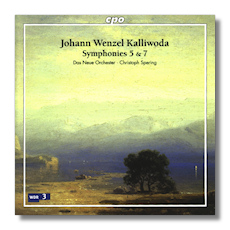
The Internet's Premier Classical Music Source
Related Links
- Latest Reviews
- More Reviews
-
By Composer
-
Collections
DVD & Blu-ray
Books
Concert Reviews
Articles/Interviews
Software
Audio
Search Amazon
Recommended Links
Site News
 CD Review
CD Review
Johann Wenzel Kalliwoda

- Symphony #5 in B minor, Op. 106
- Symphony #7 in G minor, WoO/01
- Overture #16 in A minor, Op. 238
Das Neue Orchester/Christoph Spering
CPO 777139-2 DDD 68:29
To me at least, the name "Kalliwoda" always suggested an Australian heritage (!), but he was a Bohemian, born in Prague in 1801. (An alternative spelling of his name is Jan Václav Kalivoda.) His most productive years were between 1822, when he entered into the service of Prince Carl EgonII zu Fürstenberg, and 1848, when Europe's political upheavals caused a reversal of the Prince's fortunes. Kalliwoda remained in his service for another several years, however, and then he moved to Karlsruhe, where he remained until his death in 1866.
In his helpful booklet notes to this release, Norbert Bolin advances the hypothesis that Beethoven had irrevocably transformed what it meant to be a composer of symphonies. In essence, the generation after Beethoven had to rethink the whole genre. However, the farther one got from Vienna, the less influence Beethoven's legacy exerted, and Kalliwoda arguably was relatively free to go wherever he wanted without worrying about stepping in the footprints of a giant. Robert Schumann, writing about Kalliwoda's symphonies, opined that although they were not "diadems" in the manner of Beethoven, they were "white, transparent pearls" of enduring quality.
The two symphonies recorded here were published in 1840 and 1841 respectively – happy times for the composer, or at least productive ones, as life at the Prince's estate at Donaueschingen was busy. The Fifth Symphony, which has been recorded several times, is a fine place to start one's exploration of Kalliwoda's music. It begins with a bold fanfare, and explores territory already marked out by Beethoven and Schubert. This is assertive music, full of big, decisive gestures. At the same time, there seems to be an inexhaustible supply of melodies, and Kalliwoda develops them expertly. Although there is not a lot of originality here, this is superb craftsmanship, and those who regret that Schubert did not write more symphonies should explore Kalliwoda's Fifth. (Interestingly, there are flashes of Schumann too, although Kalliwoda's development as a symphonist actually paralleled Schumann's.) Despite its numbering, the Seventh Symphony predates the Fifth. (It was published later.) Here, the mood is more Romantic than Classical; the affinity with Schumann is even stronger. Again, what the music lacks in originality it compensates for in assurance and fluency. The Overture that brings the disc to a close was published in 1863 – this was the last of Kalliwoda's 16 works in this genre. In essence, it straddles the symphonic allegro and the tone poem – although as far as we know this is absolute music – because the Kalliwoda treats his materials with relative freedom. It is not as memorable as the two symphonies, but it still is worth hearing.
Conductor Spering founded this Cologne-based "New Orchestra"in 1988. This was "the first German ensemble to apply considerations of performance practice to the music of the romantic era." Gut strings are used, the brass are valveless, and so on. Forty-three musicians participate in the overture, and forty in the two symphonies. The sound is bracing but refined, and Spering keeps the music moving along, albeit with sensitivity. The engineering is just fine. This CD is a good bet for those who are looking for that paradoxical something new that sounds familiar!
Copyright © 2006, Raymond Tuttle




















